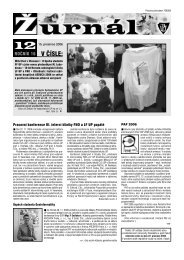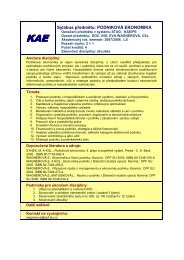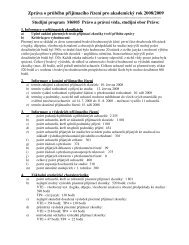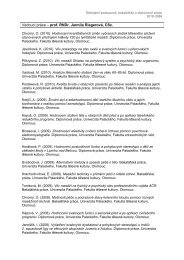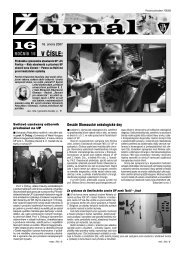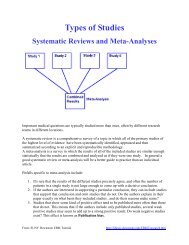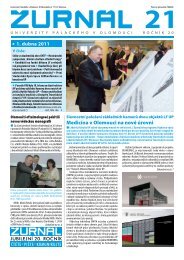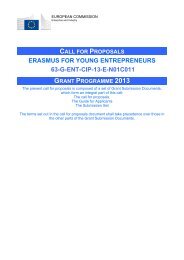ACTA UNIVERSITATIS PALACKIANAE OLOMUCENSIS GYMNICA ...
ACTA UNIVERSITATIS PALACKIANAE OLOMUCENSIS GYMNICA ...
ACTA UNIVERSITATIS PALACKIANAE OLOMUCENSIS GYMNICA ...
- No tags were found...
You also want an ePaper? Increase the reach of your titles
YUMPU automatically turns print PDFs into web optimized ePapers that Google loves.
Acta Univ. Palacki. Olomuc., Gymn. 2004, vol. 34, no. 2 35mary problem of using these indirect methods for bodycomposition assessment is the predictive equations.There are others factors, that can influence the resultsof measurements (e.g. instrumentation, subject factors,technical skill, environmental factors…). The method ofSKF measurement uses to calculation of body fat ratiothe specific predictive equations. Total error (biologicaland technical) range about 3.3% of body fat (Dlouhá,1998, 8). The accuracy of BIA measurement is infl u-enced by various factors, e.g. errors caused by devicehandling (cca 3%), method’s errors-software (80%, especiallypredictive equations), hardware – the selectedapparatus (cca 1.5%), the type of electrodes (3%), theside of body (1–2%), the selected frequency (1–2%), thehydratation of body (2–4%) and many others (Bunc,2001, 189).CONCLUSIONThere are various factors, which affect the results ofmeasurement and the assessment of body composition(e.g. technical skill, the selected apparatus, environmentalfactors…). The primary problem of using the indirectmethods for the body composition determination is thepredictive equations. DEXA method (dual energy X-rayabsorptiometry) is thought as “the gold standard”, butbecause of the high price and technology requirementsit is not useful in fields conditions (Bunc, 2001, 189).Research and our study show, that monitoring thethickness of a single skinfold or sum of SKFs (Σ SKF)is optimal for detection of changes in the amount anddistribution of subcutaneous fat (Bunc, 2001, 189).There are various apparatus working with the bioelectricimpedance principle, but not all of them found thecorresponding values. The results of bioelectric analysisare affected by the selected predictive equations. It isto accent, that the measurement should be made bya skilled person to reduce the human factor. The singlemethods measure the other physical quantity, thereforewe can’t confuse the results of the single methods. Atthe conclusion it is to accent too, that it is importantto use the same selected method for the body compositiondetermination during the longitudinal monitoringof individuals.REFERENCESBláha, P., & Vignerová, J. (1998). Percentilový graf BMI.Praha: Přírodovědecká fakulta UK.Bláha, P. et al. (1998). Percentilový graf tělesné výšky.Praha: SZÚ, ÚSM.Bunc, V., & Dlouhá, R. (1998). Možnosti stanovenítělesného složení bioimpedanční metodou u netrénovanýcha trénovaných jedinců. Med Sport BohemSlov, 7, 89a.Bunc, V. et al. (1998). Inovace predikčních rovnic pro stanovenísložení těla bioimpedanční metodou a metodouměření tloušťky kožních řas.[Dílčí zpráva GAUK].Univerzita Karlova, Fakulta tělesné výchovy a sportu,Praha.Bunc, V., Cingálek, R., Moravcová, J., & Kalous, J.(2001). Možnosti stanovení tělesného složení u dětíbioimpedanční metodou. In H. Válková & Z. Hanelová(Eds.), Pohyb a zdraví (pp. 188–190). Olomouc:Vydavatelství Univerzity Palackého.Dlouhá, R. (1998). Výživa – přehled základní problematiky.Praha: Karolinum.Dlouhá, R., Heller, J., & Bunc, V. (1998). Srovnánírovnic Pařízkové pro zjišťování tělesného tuku sportujícíchžen. Med Sport Bohem Slov, 7, 7–12.Havlíčková, L. et al. (1993). Fyziologie tělesné zátěže II.,Speciální část – 1. díl. Praha: Karolinum.Hoffmann, M. D., & Clifford, P. S. (1992). Physiologicalaspects of competitive cross-country skiing. Journalof Sports Sciences, 10, 3–27.Orvanová, E. (1987). Physical structure of winter sportsathletes. Journal of Sports Sciences, 5, 197–248.Pařízková, J. (1977). Body fat and physical fi tness. TheHaque Martinus Nijhoff B.V./Medical Division.Pařízková, J. (1994). Dietary intake and body physiquein adolescent cross-country skiers. Journal of SportsSciences, 12, 251–254.Pařízková, J. (1998). Složení těla, metody měření a využitíve výzkumu a lékařské praxi. Med Sport BohemSlov, 7, 1–6.Riegerová, J., & Ulbrichová, M. (1998). Aplikace fyzickéantropologie v tělesné výchově a sportu. Olomouc:Vydavatelství Univerzity Palackého.The study was supported by grant of Czech Ministryof Education, Youth and Sport No. MSM 115100001.TĚLESNÝ PROFIL LYŽAŘŮ BĚŽCŮVE VĚKU 10–16 LET(Souhrn anglického textu)Sledování hodnot různých tělesných charakteristikdětí a mládeže je nejjednodušším způsobem hodnocenítělesného profilu jedince či skupiny populace. Tělesnésložení, tj. velikost podílu aktivní tělesné hmoty a depotníhotuku, vytváří výrazný somatický znak, kterýse cha rakteristicky rozvíjí v závislosti na věku, stupnitělesného rozvoje a pohlaví. Cílem této studie bylo zhodnotittělesný profil u skupiny lyžařů, žáků sportovníchtříd se zaměřením na běh na lyžích, s důrazem na hodnocenízákladních antropometrických charakteristik, tj.tělesné hmotnosti, tělesné výšky, BMI a somatotypu.Dílčím cílem bylo porovnání kaliperace a bioimpe dancejako metod pro stanovení tělesného složení, resp. po-




